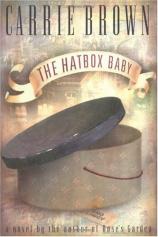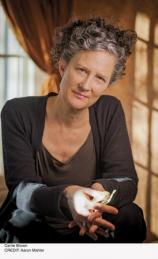The Hatbox Baby
Review
The Hatbox Baby
So
much sometimes turns on the little, unnoticed events in our lives,
and often the greatest dramas are played out among ordinary,
"normal" people. But what is "normal" anyway, in a world where
premature babies are put on exhibition at a fair alongside
fire-breathers, fan dancers, and recreations of "The Streets of
Paris?" Author Carrie Brown takes us to the Chicago World's Fair of
1933 to make these points and ask these questions in her third
novel, THE HATBOX BABY, the title of which leads one to believe the
book will be about a baby.
Well, it is about a baby, but the child only plays an active role
in the very beginning and at the very end of the story. Between
these two spaces, he is an unnamed linchpin --- in the background
in his incubator but splendidly palpable --- around which all the
characters revolve throughout the summer of 1933. And, by the end
of that summer, no one is as they began: not Dr. Leo Hoffman; not
the gorgeous fan dancer, Caroline Day (whose near-nude fan dance
takes place daily in the space next to the Infantorium); and not
Caroline's dwarf-like cousin, St. Louis Percy. All come together as
a result of the arrival of the hatbox baby and all end up with a
personal stake in its fragile but very special future.
On a sweltering June day in 1933, a young man arrives at the
Chicago World's Fair carrying a cardboard hatbox containing the
tiny body of his newborn son, who was born three months too early.
The young man is looking for Dr. Leo Hoffman, renowned medical
expert on premature babies and proprietor of one of the fair's most
popular exhibits, the "Infantorium." Hoffman's exhibit is composed
of premature infants displayed to a paying public, but he is no
petty barker dealing in human misery. The money taken in from the
exhibit goes back into the doctor's work with "preemies," and he
has saved many little lives that otherwise would have been lost,
all due to a simple accident of timing.
Following this little baby's birth, the neighbor who served as a
midwife to the young man's wife tells him, "Take it to that doctor,
the one at the fair. He's the only one can save it." So the young
man takes his tiny son to Hoffman in a cardboard hatbox, having no
idea of the chain of events this act will set into motion.
The novel evokes a misty, dreamlike quality, which contrasts
sharply with the hard realities faced each day by Dr. Hoffman and
his nurses and the raucous, semi-warped atmosphere of the carnival
that surrounds them.
"The giant, elongated shadows of early morning fell around him.
Passing through zebra stripes of light and dark, he saw fountains
and monuments, tents and bivouacs, brightly colored facades and
cool, dark passageways. Pausing at the intersection of two wide
thoroughfares, he hesitated. A vague instinct prompted him to look
up. There in the pale blue sky, between the towering canyon walls
of the exposition's architectural monuments, a dirigible balanced
lightly on a rack of cloud. Oh! It was a fantastic thing ..."
While freaks and oddities display themselves along the midway in
Dr. Hoffman's tent, babies battle for breath and life, sometimes
winning, sometimes losing. The fair's weird yet lyrical atmosphere
blankets every event and every character protectively, giving the
reader the feeling that there is no world outside this one.
Reviewed by Laura G. Carter (gcarter01@sprynet.com) on January 22, 2011
The Hatbox Baby
- Publication Date: September 22, 2000
- Genres: Fiction
- Hardcover: 368 pages
- Publisher: Algonquin Books
- ISBN-10: 1565122992
- ISBN-13: 9781565122994




